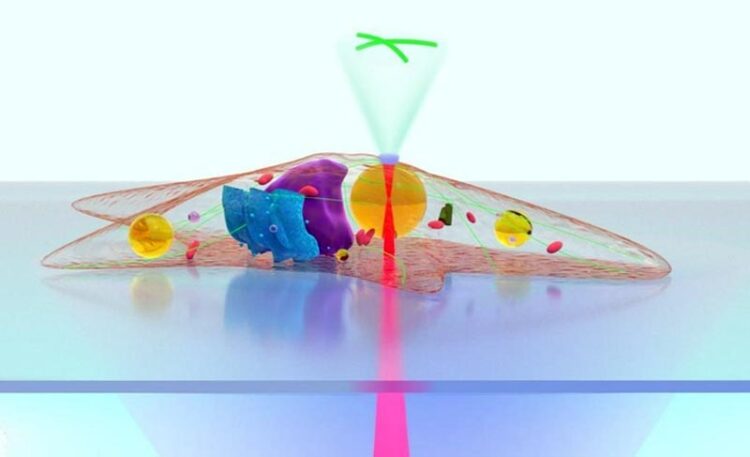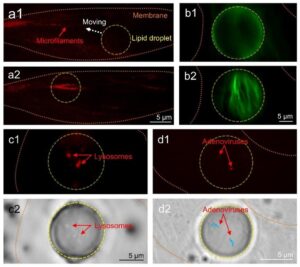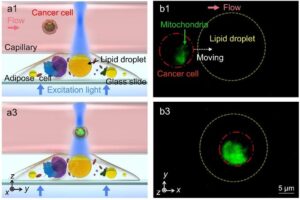Lipid droplets as endogenous intracellular microlenses

An optically trapped lipid droplet inside an adipose cell focuses the excitation light and collects the fluorescent signals from the cytoskeleton to form a magnified fluorescence image.
Credit by Xixi Chen, Tianli Wu, Zhiyong Gong, Jinghui Guo, Xiaoshuai Liu, Yao Zhang, Yuchao Li, Pietro Ferraro, and Baojun Li
With the demand in real-time monitoring of endoplasmic variations and rapid detection of extracellular signals, a great number of approaches to bioimaging have been developed. The past few decades have witnessed a dramatic progress in optical imaging, especially with the emerging of microsphere-assisted techniques that have the excellent ability of signal collection and enable real-time and super-resolution imaging with conventional optical microscopic systems.
However, as most of the microspheres in current strategies are in solid and artificially synthetic materials, they are of very low biocompatibility. Fortunately, lessons from nature have shown that some bio-components and already-existing objects can interact with light and are able to take the same functions as the real optical elements.
In a paper newly published in Light Science & Application, a team of researchers, led by Professors Baojun Li, Yao Zhang and Yuchao Li from Institute of Nanophotonics, Jinan University, China and Dr. Pietro Ferraro from CNR-ISASI, Institute of Applied Sciences and Intelligent Systems, Italy, demonstrate that lipid droplets, a sort of dynamic structures that naturally exist in cells, can act as intracellular microlenses for real-time monitoring of subcellular structures and detection of extracellular signals. With a spherical shape and a refractive index higher than cytoplasm and periplasm, the lipid droplets exhibit the lensing effect to efficiently converge both the excitation light and the fluorescence signals (Figure 1).

Credit by Xixi Chen, Tianli Wu, Zhiyong Gong, Jinghui Guo, Xiaoshuai Liu, Yao Zhang, Yuchao Li, Pietro Ferraro, and Baojun Li
To achieve intracellular imaging of subcellular structures, the lipidic microlenses work in a contact mode in which the collection efficiency of the emitted fluorescent signals was greatly increased by the lipid droplets.
As a result, the required excitation power in fluorescence imaging can be reduced by up to 73%. Driven by scanning optical tweezers, the lipid droplets can be moved inside the cell to perform an enhanced intracellular fluorescence imaging of the microfilaments, lysosomes and adenoviruses in living cells (Figure 2).
Moreover, due to the refractive index contrast of the lipid droplets to cytoplasm, the long focal length of the lipid droplets can extend the fluorescence enhancement strategies to a non-contact mode that increases the working distance of imaging and detection by the lipidic microlenses.

Credit by Xixi Chen, Tianli Wu, Zhiyong Gong, Jinghui Guo, Xiaoshuai Liu, Yao Zhang, Yuchao Li, Pietro Ferraro, and Baojun Li
In the non-contact mode, the excitation light was highly converged by the lipid droplets to enhance the fluorescence intensity from the extracellular environment surrounding the cells.
In the experiments, an efficient detecting of fluorescent signals of cancer cells in extracellular fluid was accomplished by the lipidic microlenses (Figure 3).
The presented lensing effect of the lipid droplets is expected to find applications to fully biocompatible miniaturized tools for biosensing, endoscopic analysis and single-cell diagnosis.
The use of the lipid droplets as intracellular microlenses also provides opportunities to design and construct diverse endogenous photonic devices.
DOI: 10.1038/s41377-021-00687-3
Article Title: Lipid droplets as endogenous intracellular microlenses
Article Publication Date: 6-Dec-2021
Media Contact
All latest news from the category: Medical Engineering
The development of medical equipment, products and technical procedures is characterized by high research and development costs in a variety of fields related to the study of human medicine.
innovations-report provides informative and stimulating reports and articles on topics ranging from imaging processes, cell and tissue techniques, optical techniques, implants, orthopedic aids, clinical and medical office equipment, dialysis systems and x-ray/radiation monitoring devices to endoscopy, ultrasound, surgical techniques, and dental materials.
Newest articles

Innovative 3D printed scaffolds offer new hope for bone healing
Researchers at the Institute for Bioengineering of Catalonia have developed novel 3D printed PLA-CaP scaffolds that promote blood vessel formation, ensuring better healing and regeneration of bone tissue. Bone is…

The surprising role of gut infection in Alzheimer’s disease
ASU- and Banner Alzheimer’s Institute-led study implicates link between a common virus and the disease, which travels from the gut to the brain and may be a target for antiviral…

Molecular gardening: New enzymes discovered for protein modification pruning
How deubiquitinases USP53 and USP54 cleave long polyubiquitin chains and how the former is linked to liver disease in children. Deubiquitinases (DUBs) are enzymes used by cells to trim protein…



